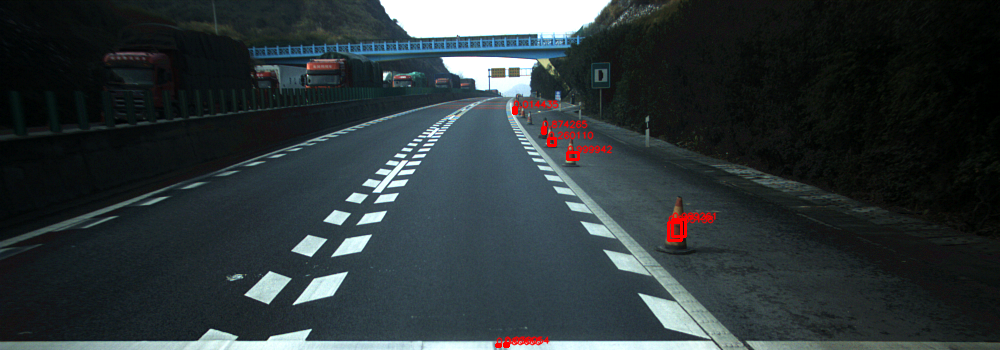问题描述:预测框的中心位置正常,但是预测的框的width和height不正常。
解决方法:使得训练的配置cfg和测试中cfg的输入width, height, anchorbox保持一致!
问题是我在修改anchorbox时遇到的,当时训练和测试不在同一环境下,测试端没有及时更新cfg文件造成的,如下图所示:

mAP也是极低的。
修改后,检测框正常,如下图所示:

下面做下boundingbox来源分析:
首先是yolo(you only look once)中是这样定义的:

算法中明确告诉我们:boundingbox只和cell(featuremap中的)位置(Cx,Cy)以及anchorbox的(Pw,Ph)直接相关。所以我们可以重点关注这两个量。
对应到源代码中的实现主要是以下两个函数:
yolo_layer.c
...
box get_yolo_box(float *x, float *biases, int n, int index, int i, int j, int lw, int lh, int w, int h, int stride) /* 输入参数解析:(*x 预测数据),(*biases 存放anchor数据), (i、j 对应在feature map上的坐标), (n 表示anchor数组的mask,为了让三个yolo_layer能取到自己对应的三组anchor, 小尺寸feature map对应大size anchor,比较好理解小尺寸特征图负责检查大尺寸目标), (index,当前bbox对应的数据的起始下标), (lw lh,特征图的w h), (w h, 网络输入的w h), (同一个bbox数据之间的stride lw*lh) */ { box b; // 网络为了每一个bbox都给出了4个坐标预测值: tx ty tw ty /* 其中tx 和 ty是相对于当前feature map坐标的偏移 除以lw&&lh 是计算出bbox坐标在图像中的比例 */ b.x = (i + x[index + 0*stride]) / lw; b.y = (j + x[index + 1*stride]) / lh; /* e^tw * biases[2*n] 表示学习到的w回归值和对应prior bbox(anchor) w的乘积得到 bbox在网络输入size基础上的w size, 除以 net_w得到相对于网络输入图像的比例 h的计算同理, 这部分的内容涉及到yolov3论文中的图二 */ b.w = exp(x[index + 2*stride]) * biases[2*n] / w; b.h = exp(x[index + 3*stride]) * biases[2*n+1] / h; return b; /*补充一下,这里算出的x,y,w,h都是相对于net input size的比例*/ }
此不分为转载:
https://blog.csdn.net/wwwhp/article/details/84718089
... int get_yolo_detections(layer l, int w, int h, int netw, int neth, float thresh, int *map, int relative, detection *dets) { int i,j,n; float *predictions = l.output; if (l.batch == 2) avg_flipped_yolo(l); int count = 0; for (i = 0; i < l.w*l.h; ++i){ int row = i / l.w; int col = i % l.w; //printf("get_yolo_detections:i =%d,row = i / l.w=%d, col = i % l.w; ",i, row, col); for(n = 0; n < l.n; ++n){ int obj_index = entry_index(l, 0, n*l.w*l.h + i, 4); float objectness = predictions[obj_index];//objectness:有框的 //printf("objectness:%f ",objectness); if(objectness <= thresh) continue; printf("obj_index = %d,objectness:%f, thresh:%f ",obj_index,objectness,thresh); int box_index = entry_index(l, 0, n*l.w*l.h + i, 0); dets[count].bbox = get_yolo_box(predictions, l.biases, l.mask[n], box_index, col, row, l.w, l.h, netw, neth, l.w*l.h);//模型推理出偏移量 dets[count].objectness = objectness; dets[count].classes = l.classes; for(j = 0; j < l.classes; ++j){ int class_index = entry_index(l, 0, n*l.w*l.h + i, 4 + 1 + j); float prob = objectness*predictions[class_index];//predictions[class_index]:框中物体是class的概率,prob:置信度 printf("get_yolo_detections1:prob=objectness*predictions[class_index] = %f * predictions[%d] = %f * %f = %f; ",objectness,class_index,objectness,predictions[class_index],prob); dets[count].prob[j] = (prob > thresh) ? prob : 0; printf("get_yolo_detections2:[dets[count].prob[j] = (prob > thresh) ? prob : 0] = [ %f = (%f > %f) ? %f : 0]; ",dets[count].prob[j],prob,thresh,prob); } ++count; } } correct_yolo_boxes(dets, count, w, h, netw, neth, relative); return count; } ...
如有疑问可以留言。
希望可以帮到困惑的你!